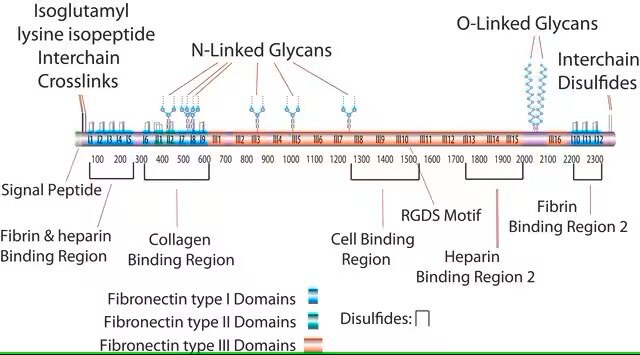F2006
Human Fibronectin
from human plasma, powder, suitable for cell culture
Synonym(s):
Fibronectin
About This Item
Recommended Products
product name
Fibronectin human plasma, lyophilized powder, BioReagent, suitable for cell culture
biological source
human plasma
Quality Level
sterility
sterile
product line
BioReagent
Assay
≥85% (SDS-PAGE)
form
lyophilized powder
mol wt
450 kDa
packaging
pkg of 5 x 5 mg
pkg of 1 mg
pkg of 2 mg
pkg of 5 mg
concentration
>1 mg/mL protein
technique(s)
cell culture | mammalian: suitable
surface coverage
1‑5 μg/cm2
impurities
HBSAG, none detected
HCV, none detected
HIV-1/HIV-2, none detected
solubility
H2O: 1 mg/mL at 37 °C (Store reconstituted solution in working aliquots at -20°C or lower.)
NCBI accession no.
UniProt accession no.
Binding Specificity
Peptide Source: Collagen
shipped in
dry ice
storage temp.
−20°C
Gene Information
human ... FN1(2335)
Looking for similar products? Visit Product Comparison Guide
General description
Application
- Used in cell seeding and neuronal differentiation (as one of the components in expansion medium for the re-suspension of CBSCs (Cord blood stem cells) and is also used in differentiation medium)
- Used in cell culture (the culture chamber was coated with fibronectin for the expression of HEK293 cells)
- In-vitro fibronectin (FN) pulldown assays
- Protein specificity
- Used in cell migration study
Biochem/physiol Actions
Caution
Preparation Note
Disclaimer
Storage Class Code
11 - Combustible Solids
WGK
WGK 3
Flash Point(F)
Not applicable
Flash Point(C)
Not applicable
Personal Protective Equipment
Regulatory Listings
Regulatory Listings are mainly provided for chemical products. Only limited information can be provided here for non-chemical products. No entry means none of the components are listed. It is the user’s obligation to ensure the safe and legal use of the product.
JAN Code
F2006-1MG-PW:
F2006-2MG-PW:
F2006-5MG-PW:
F2006-BULK-N:
F2006-2MG:
F2006PROC:
F2006-5MG:
F2006-BULK:
F2006-5X5MG:
F2006-PH:
F2006-1MG:
F2006-VAR:
Certificates of Analysis (COA)
Search for Certificates of Analysis (COA) by entering the products Lot/Batch Number. Lot and Batch Numbers can be found on a product’s label following the words ‘Lot’ or ‘Batch’.
Already Own This Product?
Find documentation for the products that you have recently purchased in the Document Library.
Customers Also Viewed
Articles
Fibronectin (FN) is a multifunctional, extracellular plasma glycoprotein produced by hepatocytes that circulates at near micromolar concentration and assembles into extracellular matrix fibrils at cell surfaces along with locally produced cellular FN.
Attachment Factors for 3-Dimensional Cell Culture
The extracellular matrix (ECM) is secreted by cells and surrounds them in tissues.
3D cell culture overview. Learn about 2D vs 3D cell culture, advantages of 3D cell culture, and techniques available to develop 3D cell models
Protocols
Dilute fibronectin to the desired concentration. Optimum conditions for attachment are dependent on cell type and application. The typical coating concentration is 1 – 5 ug/cm2.Fibronectin coating protocol, products, and FAQs.
Our team of scientists has experience in all areas of research including Life Science, Material Science, Chemical Synthesis, Chromatography, Analytical and many others.
Contact Technical Service







